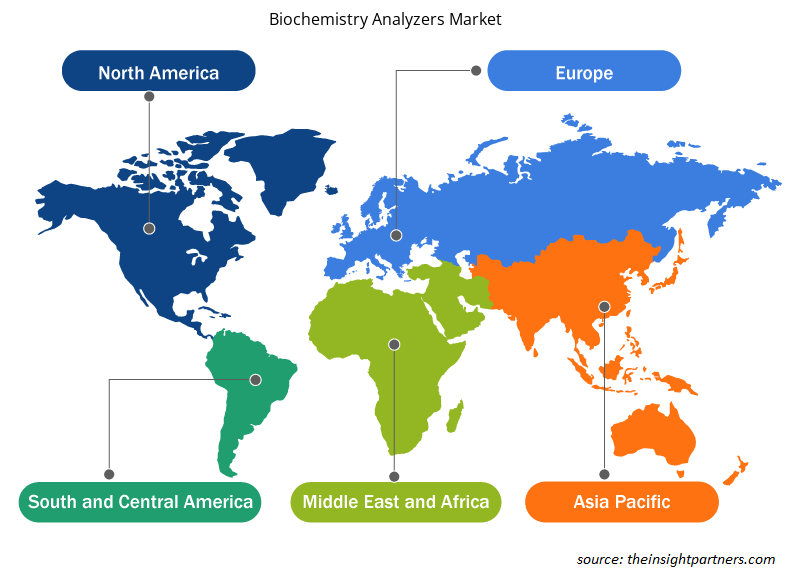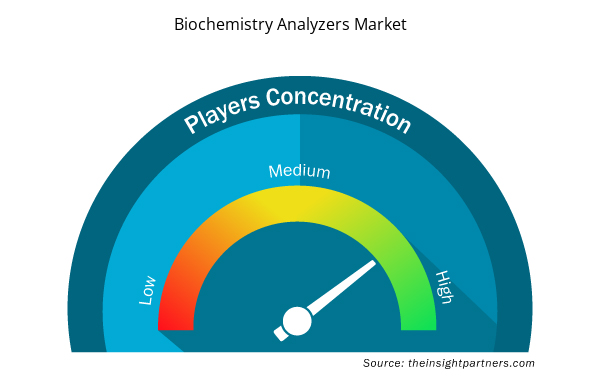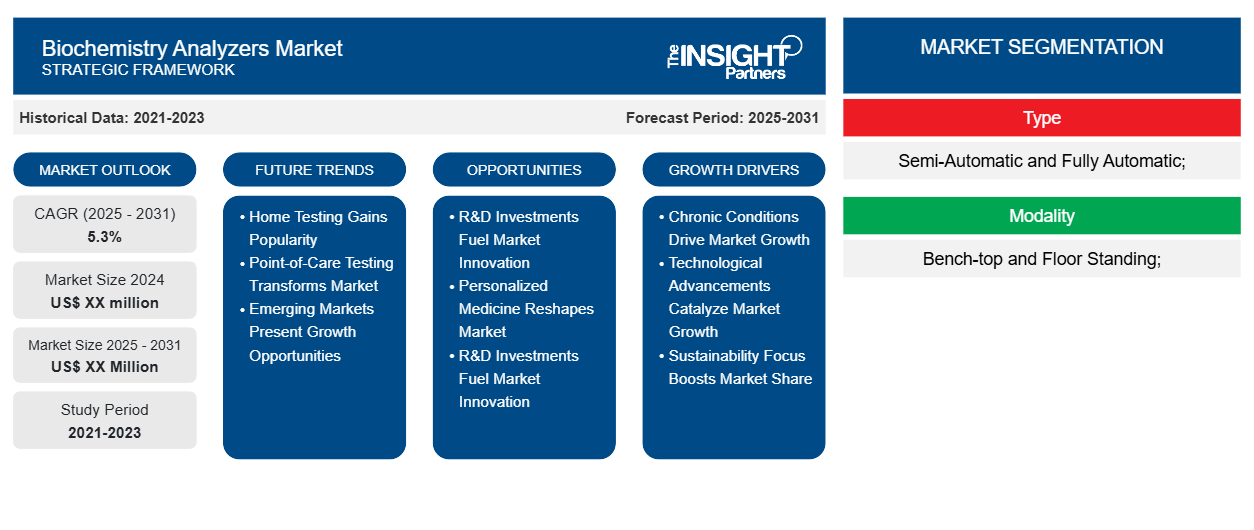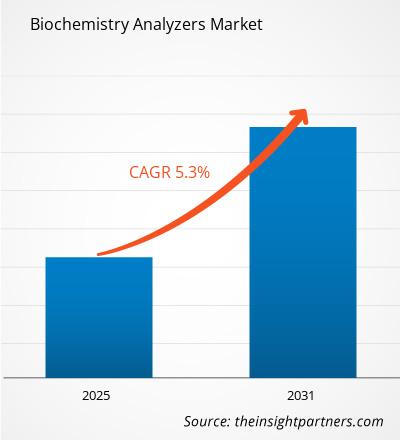Si prevede che il mercato degli analizzatori biochimici registrerà un CAGR del 5,3% dal 2023 al 2031, con una dimensione di mercato in espansione da XX milioni di dollari nel 2023 a XX milioni di dollari entro il 2031.
Il report di mercato degli analizzatori biochimici copre l'analisi per tipo, modalità e utente finale. L'analisi globale è ulteriormente suddivisa a livello regionale e nei principali paesi. Il report offre il valore in dollari USA per l'analisi e i segmenti di cui sopra.
Scopo del rapporto
Il report Biochemistry Analyzers Market di The Insight Partners mira a descrivere il panorama attuale e la crescita futura, i principali fattori trainanti, le sfide e le opportunità. Ciò fornirà spunti a vari stakeholder aziendali, come:
- Fornitori/produttori di tecnologia: per comprendere le dinamiche di mercato in evoluzione e conoscere le potenziali opportunità di crescita, consentendo loro di prendere decisioni strategiche informate.
- Investitori: condurre un'analisi completa delle tendenze in merito al tasso di crescita del mercato, alle proiezioni finanziarie del mercato e alle opportunità esistenti lungo la catena del valore.
- Enti di regolamentazione: regolamentano le politiche e le attività di controllo sul mercato allo scopo di ridurre al minimo gli abusi, preservare la fiducia degli investitori e sostenere l'integrità e la stabilità del mercato.
Segmentazione del mercato degli analizzatori biochimici
Tipo
- Semiautomatico e completamente automatico;
Modalità
- Da banco e da pavimento;
Utente finale
- Ospedali
- Centri Diagnostici
- Aziende farmaceutiche e biotecnologiche
- Istituti di ricerca
- Organizzazioni di ricerca a contratto
Geografia
- America del Nord
- Europa
- Asia-Pacifico
- America del Sud e Centro
- Medio Oriente e Africa
Geografia
- America del Nord
- Europa
- Asia-Pacifico
- America del Sud e Centro
- Medio Oriente e Africa
Personalizza questo report in base alle tue esigenze
Riceverai la personalizzazione gratuita di qualsiasi report, comprese parti di questo report, o analisi a livello nazionale, pacchetto dati Excel, oltre a usufruire di grandi offerte e sconti per start-up e università
- Scopri le principali tendenze di mercato in questo rapporto.Questo campione GRATUITO includerà analisi di dati che spaziano dalle tendenze di mercato alle stime e alle previsioni.
Fattori trainanti della crescita del mercato degli analizzatori biochimici
- Le condizioni croniche guidano la crescita del mercato: l'aumento della prevalenza di condizioni croniche, come diabete e disturbi cardiovascolari, è uno dei principali fattori di crescita per il mercato degli analizzatori biochimici. La tendenza è considerata relativamente significativa nel mercato globale, con diversi ospedali e laboratori che investono nelle tecnologie per migliorare i risultati diagnostici.
- I progressi tecnologici catalizzano la crescita del mercato: i progressi tecnologici negli analizzatori biochimici stanno agendo come uno dei principali catalizzatori per la crescita del mercato degli analizzatori biochimici. L'automazione, la miniaturizzazione e lo sviluppo della sensibilità hanno cambiato totalmente la capacità diagnostica, consentendo risultati rapidi e accurati. Poiché tali strumenti avanzati iniziano a far sentire la loro presenza in modo più significativo nelle strutture sanitarie a livello globale, la domanda ha iniziato a crescere rapidamente nel mercato globale.
- L'attenzione alla sostenibilità aumenta la quota di mercato: questa tendenza è particolarmente evidente nei mercati emergenti, dove il miglioramento delle strutture sanitarie porta ulteriormente a tassi di adozione più elevati per gli analizzatori biochimici. Il rapporto di mercato indica che questo flusso nell'investimento è molto cruciale affinché la crescita si realizzi nel mercato e ha anche un effetto positivo sulla quota di mercato e sulle tendenze del mercato globale.
Analizzatori biochimici Tendenze future del mercato
- I test domestici guadagnano popolarità: la crescita del mercato degli analizzatori biochimici sta osservando un crescente stress sulla sostenibilità, in cui la maggior parte dei produttori si sta concentrando su prodotti eco-compatibili. Gli studi di ricerca indicano che quasi il 40% dei laboratori sta mostrando interesse per alternative più ecologiche per l'approvvigionamento. Un'analisi PEST indica un aumento della pressione normativa sulla sostenibilità. I principali attori del mercato stanno quindi utilizzando strategie di mercato correlate ai benefici ambientali dei prodotti per attrarre una base di consumatori preoccupata per la prospettiva di sostenibilità nell'approvvigionamento di apparecchiature sanitarie.
- I test Point-of-Care trasformano il mercato: le soluzioni di test domiciliari per l'analisi biochimica sono diventate sempre più popolari, soprattutto in vista della pandemia di COVID-19. I sondaggi evidenziano che circa il 45% dei consumatori ha manifestato interesse per i test domiciliari come un modo per monitorare la salute. Ciò costituisce dinamiche di mercato legate alla ricerca di praticità e accessibilità. Un'analisi SWOT sarebbe utile, quindi, per evidenziare le opportunità disponibili per i principali attori per il sequestro di apparecchiature di test domiciliari di facile utilizzo. Le strategie di mercato a questo riguardo dovrebbero, quindi, mirare allo sviluppo dell'offerta di prodotti in collaborazione con le aziende tecnologiche.
- I mercati emergenti presentano opportunità di crescita: i test point-of-care stanno rielaborando in modo potente la curva del mercato degli analizzatori biochimici. Dati recenti indicano che circa il 55% degli operatori sanitari si sta muovendo verso l'adozione del POCT con l'obiettivo di migliorare i risultati dei pazienti e ridurre i tempi di risposta. Ciò è avvenuto in un momento in cui le recenti dinamiche di mercato sono favorevoli alla diagnosi rapida. Un'analisi SWOT individuerebbe le opportunità disponibili per i principali attori nello sviluppo di analizzatori compatti ed efficienti. Per tali scenari di mercato in evoluzione, le strategie che si occupano dell'integrazione con le tecnologie mobili sono vitali.
Opportunità di mercato degli analizzatori biochimici
- Gli investimenti in R&S alimentano l'innovazione del mercato: mentre il Nord America rimane un hub strategico, i mercati emergenti presentano enormi opportunità di crescita negli analizzatori biochimici. Ciò può essere ottenuto espandendo la presenza dell'azienda in regioni che registrano investimenti crescenti nel settore sanitario e miglioramenti nelle infrastrutture. Le dinamiche stanno cambiando in ogni continente: il rapporto analitico competitivo illustra che le aziende disposte ad adattare la propria offerta di prodotti per soddisfare le esigenze dei diversi mercati emergenti ne trarranno effettivamente beneficio. Una tale strategia di espansione globale aiuterà le aziende a sfruttare nuove basi di clienti e a rafforzare notevolmente il loro posizionamento sul mercato.
- La medicina personalizzata rimodella il mercato: gli investimenti in ricerca e sviluppo sono, quindi, un catalizzatore significativo per l'innovazione nel mercato degli analizzatori biochimici. Le aziende nordamericane, di conseguenza, rimangono all'avanguardia nel promuovere l'avvento degli analizzatori di nuova generazione per soddisfare le tecnologie e le metodologie in evoluzione. L'analisi competitiva punta a una crescente attenzione alla R&S, creando così opportunità di crescita tra quelle organizzazioni in grado di impegnare risorse per progredire nel campo. Ulteriori ricerche stanno trovando continuamente nuovi usi e applicazioni, il che significa che il mercato continuerà a crescere, soprattutto per i primi utilizzatori di tecnologie innovative.
- Investimenti in R&S alimentano l'innovazione del mercato: questa ascesa della medicina personalizzata rimodella di conseguenza il mercato degli analizzatori biochimici, dove gli operatori sanitari sono alla ricerca di strumenti che li aiutino a personalizzare il trattamento per il paziente. Con un'elevata domanda di analizzatori che dettagliano informazioni metaboliche e genetiche, il panorama industriale del Nord America è favorevole a tali progressi, con un supporto normativo visto verso i trattamenti personalizzati. L'enfasi quindi sulle soluzioni sanitarie personalizzate crea una promettente opportunità di crescita per le aziende che mirano a sviluppare analizzatori biochimici mirati a diverse esigenze dei pazienti.
Analisi di mercato degli analizzatori biochimici - Approfondimenti regionali
Le tendenze regionali e i fattori che influenzano il mercato degli analizzatori biochimici durante il periodo di previsione sono stati ampiamente spiegati dagli analisti di Insight Partners. Questa sezione discute anche i segmenti e la geografia del mercato degli analizzatori biochimici in Nord America, Europa, Asia Pacifico, Medio Oriente e Africa e America meridionale e centrale.

- Ottieni i dati specifici regionali per il mercato degli analizzatori biochimici
Ambito del rapporto di mercato degli analizzatori biochimici
| Attributo del report | Dettagli |
|---|---|
| Dimensioni del mercato nel 2023 | XX milioni di dollari USA |
| Dimensioni del mercato entro il 2031 | XX milioni di dollari USA |
| CAGR globale (2023-2031) | 5,3% |
| Dati storici | 2021-2022 |
| Periodo di previsione | 2024-2031 |
| Segmenti coperti | Per tipo
|
| Regioni e Paesi coperti | America del Nord
|
| Leader di mercato e profili aziendali chiave |
|
Analizzatori biochimici Mercato degli attori Densità: comprendere il suo impatto sulle dinamiche aziendali
Il mercato degli analizzatori biochimici sta crescendo rapidamente, spinto dalla crescente domanda degli utenti finali dovuta a fattori quali l'evoluzione delle preferenze dei consumatori, i progressi tecnologici e una maggiore consapevolezza dei benefici del prodotto. Con l'aumento della domanda, le aziende stanno ampliando le loro offerte, innovando per soddisfare le esigenze dei consumatori e capitalizzando sulle tendenze emergenti, il che alimenta ulteriormente la crescita del mercato.
La densità degli operatori di mercato si riferisce alla distribuzione di aziende o società che operano in un particolare mercato o settore. Indica quanti concorrenti (operatori di mercato) sono presenti in un dato spazio di mercato in relazione alle sue dimensioni o al valore di mercato totale.
Le principali aziende che operano nel mercato degli analizzatori biochimici sono:
- Roche Diagnostics GmbH
- Siemens AG
- Beckman Coulter Inc. (Danaher)
- Abbott Diagnostics Inc.
- Azienda: Shenzhen Mindray Bio-Medical Electronics Co., Ltd.
Disclaimer : le aziende elencate sopra non sono classificate secondo un ordine particolare.

- Ottieni la panoramica dei principali attori del mercato degli analizzatori biochimici
Punti di forza chiave
- Copertura completa: il rapporto copre in modo completo l'analisi di prodotti, servizi, tipologie e utenti finali del mercato degli analizzatori biochimici, fornendo una panoramica olistica.
- Analisi degli esperti: il rapporto è compilato sulla base della conoscenza approfondita di esperti e analisti del settore.
- Informazioni aggiornate: il rapporto garantisce la pertinenza aziendale grazie alla copertura di informazioni recenti e tendenze nei dati.
- Opzioni di personalizzazione: questo report può essere personalizzato per soddisfare le esigenze specifiche del cliente e adattarsi in modo appropriato alle strategie aziendali.
Il rapporto di ricerca sul mercato degli analizzatori biochimici può, quindi, aiutare a guidare il percorso di decodifica e comprensione dello scenario del settore e delle prospettive di crescita. Sebbene possano esserci alcune preoccupazioni valide, i vantaggi complessivi di questo rapporto tendono a superare gli svantaggi.
- Analisi storica (2 anni), anno base, previsione (7 anni) con CAGR
- Analisi PEST e SWOT
- Valore/volume delle dimensioni del mercato - Globale, regionale, nazionale
- Industria e panorama competitivo
- Set di dati Excel



Report Coverage
Revenue forecast, Company Analysis, Industry landscape, Growth factors, and Trends

Segment Covered
This text is related
to segments covered.

Regional Scope
North America, Europe, Asia Pacific, Middle East & Africa, South & Central America

Country Scope
This text is related
to country scope.
Domande frequenti
Some of the customization options available based on request are additional 3-5 company profiles and country-specific analysis of 3-5 countries of your choice. Customizations are to be requested/discussed before making final order confirmation, as our team would review the same and check the feasibility.
Key companies in this market are: Roche Diagnostics GmbH, Siemens AG, Beckman Coulter Inc. (Danaher), Abbott Diagnostics Inc., Shenzhen Mindray Bio-Medical Electronics Co., Ltd., Hologic, Inc., Randox Laboratories Ltd, Awareness Technology, Inc., Transasia Biomedicals Ltd., Nova Biomedical Corp.
The Biochemistry Analyzers Market is expected to register a CAGR of 5.3% from 2023-2031.
Key future trends in this market are - Increase in diagnostic testing, Advances in automation technology, Growth in point-of-care devices
The major factors impacting the Biochemistry Analyzers Market are: Rising Prevalence of Chronic Diseases, Technological Advancements in Diagnostic Tools, and Increasing Investments in Healthcare Infrastructure
The report can be delivered in PDF/PPT format; we can also share excel dataset based on the request.
Trends and growth analysis reports related to Life Sciences : READ MORE..
The List of Companies
1. Roche Diagnostics GmbH
2. Siemens AG
3. Beckman Coulter Inc. (Danaher)
4. Abbott Diagnostics Inc.
5. Shenzhen Mindray Bio-Medical Electronics Co., Ltd.
6. Hologic, Inc.
7. Randox Laboratories Ltd
8. Awareness Technology, Inc.
9. Transasia Biomedicals Ltd.
10. Nova Biomedical Corp.
11. Thermo Fisher Scientific Inc.
12. Horiba, Ltd.
13. Meril Life Science Pvt. Ltd.
14. Hitachi
15. Shanghai Kehua Bio-Engineering co., Ltd.
16. Abaxis
17. ELITech
18. Sunostik
19. Sysmex
20. Adaltis
The Insight Partners performs research in 4 major stages: Data Collection & Secondary Research, Primary Research, Data Analysis and Data Triangulation & Final Review.
- Data Collection and Secondary Research:
As a market research and consulting firm operating from a decade, we have published and advised several client across the globe. First step for any study will start with an assessment of currently available data and insights from existing reports. Further, historical and current market information is collected from Investor Presentations, Annual Reports, SEC Filings, etc., and other information related to company’s performance and market positioning are gathered from Paid Databases (Factiva, Hoovers, and Reuters) and various other publications available in public domain.
Several associations trade associates, technical forums, institutes, societies and organization are accessed to gain technical as well as market related insights through their publications such as research papers, blogs and press releases related to the studies are referred to get cues about the market. Further, white papers, journals, magazines, and other news articles published in last 3 years are scrutinized and analyzed to understand the current market trends.
- Primary Research:
The primarily interview analysis comprise of data obtained from industry participants interview and answers to survey questions gathered by in-house primary team.
For primary research, interviews are conducted with industry experts/CEOs/Marketing Managers/VPs/Subject Matter Experts from both demand and supply side to get a 360-degree view of the market. The primary team conducts several interviews based on the complexity of the markets to understand the various market trends and dynamics which makes research more credible and precise.
A typical research interview fulfils the following functions:
- Provides first-hand information on the market size, market trends, growth trends, competitive landscape, and outlook
- Validates and strengthens in-house secondary research findings
- Develops the analysis team’s expertise and market understanding
Primary research involves email interactions and telephone interviews for each market, category, segment, and sub-segment across geographies. The participants who typically take part in such a process include, but are not limited to:
- Industry participants: VPs, business development managers, market intelligence managers and national sales managers
- Outside experts: Valuation experts, research analysts and key opinion leaders specializing in the electronics and semiconductor industry.
Below is the breakup of our primary respondents by company, designation, and region:

Once we receive the confirmation from primary research sources or primary respondents, we finalize the base year market estimation and forecast the data as per the macroeconomic and microeconomic factors assessed during data collection.
- Data Analysis:
Once data is validated through both secondary as well as primary respondents, we finalize the market estimations by hypothesis formulation and factor analysis at regional and country level.
- Macro-Economic Factor Analysis:
We analyse macroeconomic indicators such the gross domestic product (GDP), increase in the demand for goods and services across industries, technological advancement, regional economic growth, governmental policies, the influence of COVID-19, PEST analysis, and other aspects. This analysis aids in setting benchmarks for various nations/regions and approximating market splits. Additionally, the general trend of the aforementioned components aid in determining the market's development possibilities.
- Country Level Data:
Various factors that are especially aligned to the country are taken into account to determine the market size for a certain area and country, including the presence of vendors, such as headquarters and offices, the country's GDP, demand patterns, and industry growth. To comprehend the market dynamics for the nation, a number of growth variables, inhibitors, application areas, and current market trends are researched. The aforementioned elements aid in determining the country's overall market's growth potential.
- Company Profile:
The “Table of Contents” is formulated by listing and analyzing more than 25 - 30 companies operating in the market ecosystem across geographies. However, we profile only 10 companies as a standard practice in our syndicate reports. These 10 companies comprise leading, emerging, and regional players. Nonetheless, our analysis is not restricted to the 10 listed companies, we also analyze other companies present in the market to develop a holistic view and understand the prevailing trends. The “Company Profiles” section in the report covers key facts, business description, products & services, financial information, SWOT analysis, and key developments. The financial information presented is extracted from the annual reports and official documents of the publicly listed companies. Upon collecting the information for the sections of respective companies, we verify them via various primary sources and then compile the data in respective company profiles. The company level information helps us in deriving the base number as well as in forecasting the market size.
- Developing Base Number:
Aggregation of sales statistics (2020-2022) and macro-economic factor, and other secondary and primary research insights are utilized to arrive at base number and related market shares for 2022. The data gaps are identified in this step and relevant market data is analyzed, collected from paid primary interviews or databases. On finalizing the base year market size, forecasts are developed on the basis of macro-economic, industry and market growth factors and company level analysis.
- Data Triangulation and Final Review:
The market findings and base year market size calculations are validated from supply as well as demand side. Demand side validations are based on macro-economic factor analysis and benchmarks for respective regions and countries. In case of supply side validations, revenues of major companies are estimated (in case not available) based on industry benchmark, approximate number of employees, product portfolio, and primary interviews revenues are gathered. Further revenue from target product/service segment is assessed to avoid overshooting of market statistics. In case of heavy deviations between supply and demand side values, all thes steps are repeated to achieve synchronization.
We follow an iterative model, wherein we share our research findings with Subject Matter Experts (SME’s) and Key Opinion Leaders (KOLs) until consensus view of the market is not formulated – this model negates any drastic deviation in the opinions of experts. Only validated and universally acceptable research findings are quoted in our reports.
We have important check points that we use to validate our research findings – which we call – data triangulation, where we validate the information, we generate from secondary sources with primary interviews and then we re-validate with our internal data bases and Subject matter experts. This comprehensive model enables us to deliver high quality, reliable data in shortest possible time.


 Ottieni un campione gratuito per questo repot
Ottieni un campione gratuito per questo repot